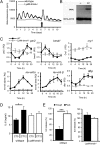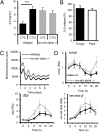The nuclear receptor REV-ERBα mediates circadian regulation of innate immunity through selective regulation of inflammatory cytokines
- PMID: 22184247
- PMCID: PMC3258648
- DOI: 10.1073/pnas.1106750109
The nuclear receptor REV-ERBα mediates circadian regulation of innate immunity through selective regulation of inflammatory cytokines
Abstract
Diurnal variation in inflammatory and immune function is evident in the physiology and pathology of humans and animals, but molecular mechanisms and mediating cell types that provide this gating remain unknown. By screening cytokine responses in mice to endotoxin challenge at different times of day, we reveal that the magnitude of response exhibited pronounced temporal dependence, yet only within a subset of proinflammatory cytokines. Disruption of the circadian clockwork in macrophages (primary effector cells of the innate immune system) by conditional targeting of a key clock gene (bmal1) removed all temporal gating of endotoxin-induced cytokine response in cultured cells and in vivo. Loss of circadian gating was coincident with suppressed rev-erbα expression, implicating this nuclear receptor as a potential link between the clock and inflammatory pathways. This finding was confirmed in vivo and in vitro through genetic and pharmacological modulation of REV-ERBα activity. Circadian gating of endotoxin response was lost in rev-erbα(-/-) mice and in cultured macrophages from these animals, despite maintenance of circadian rhythmicity within these cells. Using human macrophages, which show circadian clock gene oscillations and rhythmic endotoxin responses, we demonstrate that administration of a synthetic REV-ERB ligand, or genetic knockdown of rev-erbα expression, is effective at modulating the production and release of the proinflammatory cytokine IL-6. This work demonstrates that the macrophage clockwork provides temporal gating of systemic responses to endotoxin, and identifies REV-ERBα as the key link between the clock and immune function. REV-ERBα may therefore represent a unique therapeutic target in human inflammatory disease.
Conflict of interest statement
The authors declare no conflict of interest.
Figures





Similar articles
-
Circadian clock component REV-ERBα controls homeostatic regulation of pulmonary inflammation.J Clin Invest. 2018 Jun 1;128(6):2281-2296. doi: 10.1172/JCI93910. Epub 2018 Apr 30. J Clin Invest. 2018. PMID: 29533925 Free PMC article.
-
A circadian clock gene, Rev-erbα, modulates the inflammatory function of macrophages through the negative regulation of Ccl2 expression.J Immunol. 2014 Jan 1;192(1):407-17. doi: 10.4049/jimmunol.1301982. Epub 2013 Dec 4. J Immunol. 2014. PMID: 24307731
-
Circadian rhythm-dependent and circadian rhythm-independent impacts of the molecular clock on type 3 innate lymphoid cells.Sci Immunol. 2019 Oct 4;4(40):eaay7501. doi: 10.1126/sciimmunol.aay7501. Sci Immunol. 2019. PMID: 31586012 Free PMC article.
-
Dissecting the Rev-erbα Cistrome and the Mechanisms Controlling Circadian Transcription in Liver.Cold Spring Harb Symp Quant Biol. 2015;80:233-8. doi: 10.1101/sqb.2015.80.027508. Epub 2015 Sep 14. Cold Spring Harb Symp Quant Biol. 2015. PMID: 26370410 Review.
-
Circadian clock proteins and immunity.Immunity. 2014 Feb 20;40(2):178-86. doi: 10.1016/j.immuni.2014.02.002. Immunity. 2014. PMID: 24560196 Review.
Cited by
-
Neutrophils in Physiology and Pathology.Annu Rev Pathol. 2024 Jan 24;19:227-259. doi: 10.1146/annurev-pathmechdis-051222-015009. Annu Rev Pathol. 2024. PMID: 38265879 Free PMC article. Review.
-
Therapeutic potential of exosomes/miRNAs in polycystic ovary syndrome induced by the alteration of circadian rhythms.Front Endocrinol (Lausanne). 2022 Nov 16;13:918805. doi: 10.3389/fendo.2022.918805. eCollection 2022. Front Endocrinol (Lausanne). 2022. PMID: 36465652 Free PMC article. Review.
-
The circadian regulator PER1 promotes cell reprogramming by inhibiting inflammatory signaling from macrophages.PLoS Biol. 2023 Dec 4;21(12):e3002419. doi: 10.1371/journal.pbio.3002419. eCollection 2023 Dec. PLoS Biol. 2023. PMID: 38048364 Free PMC article.
-
Disruption of Sirtuin 1-Mediated Control of Circadian Molecular Clock and Inflammation in Chronic Obstructive Pulmonary Disease.Am J Respir Cell Mol Biol. 2015 Dec;53(6):782-92. doi: 10.1165/rcmb.2014-0474OC. Am J Respir Cell Mol Biol. 2015. PMID: 25905433 Free PMC article.
-
Role of Inflammatory Signaling in the Differential Effects of Saturated and Poly-unsaturated Fatty Acids on Peripheral Circadian Clocks.EBioMedicine. 2016 May;7:100-11. doi: 10.1016/j.ebiom.2016.03.037. Epub 2016 Mar 31. EBioMedicine. 2016. PMID: 27322464 Free PMC article.
References
Publication types
MeSH terms
Substances
Grants and funding
LinkOut - more resources
Full Text Sources
Other Literature Sources
Molecular Biology Databases

